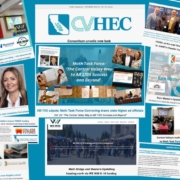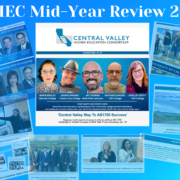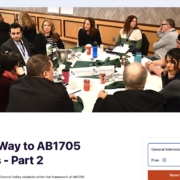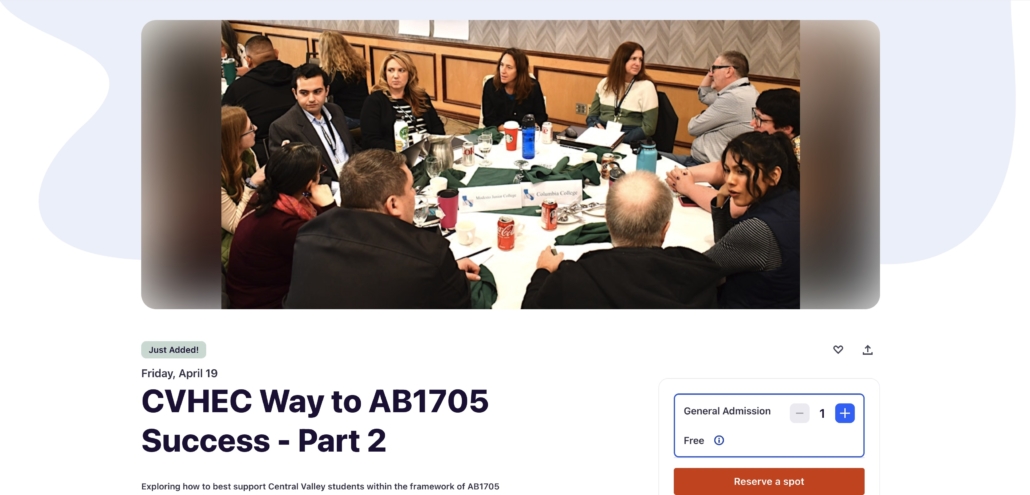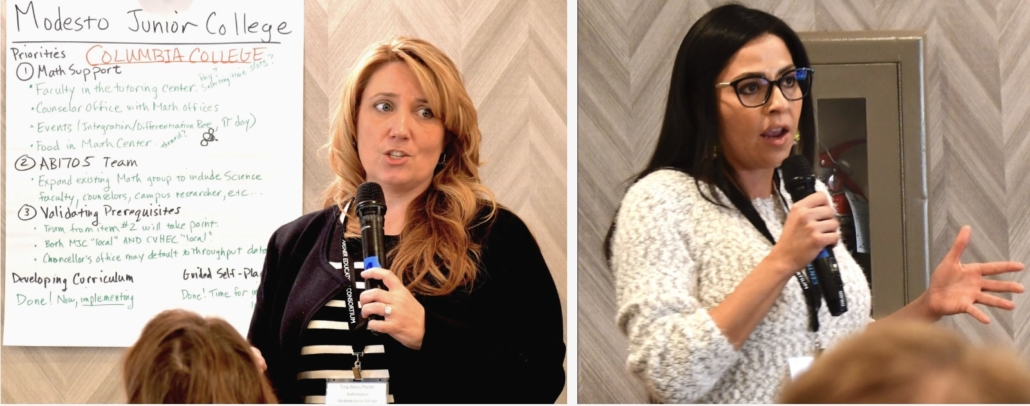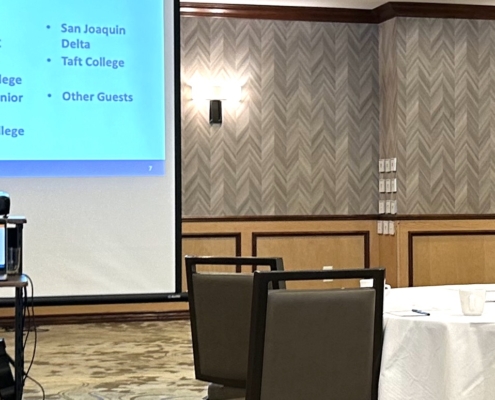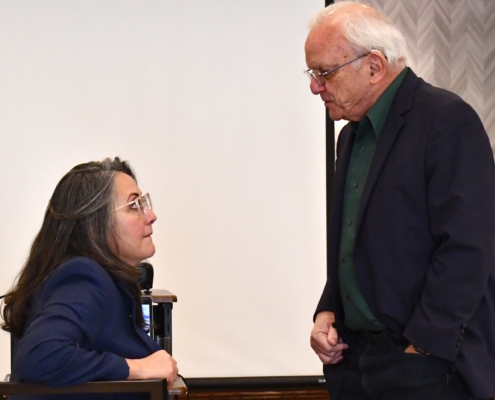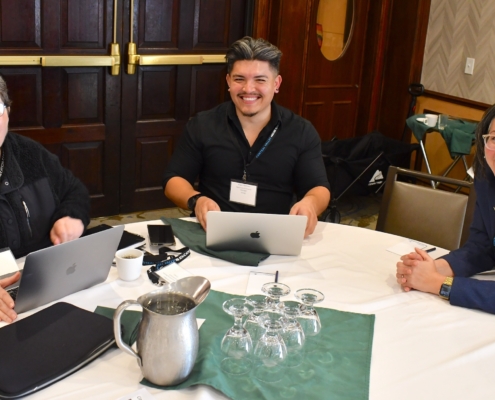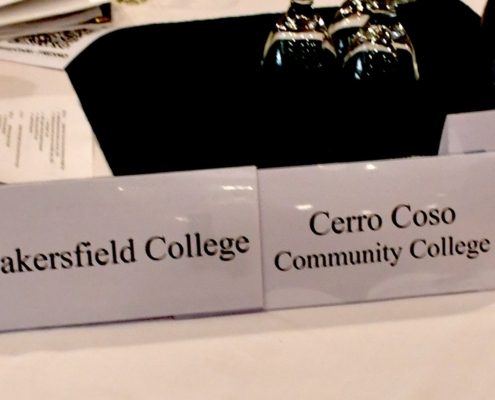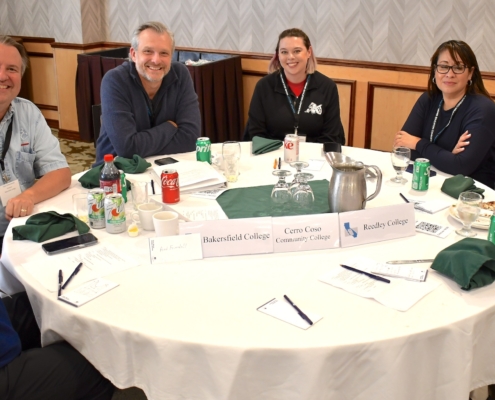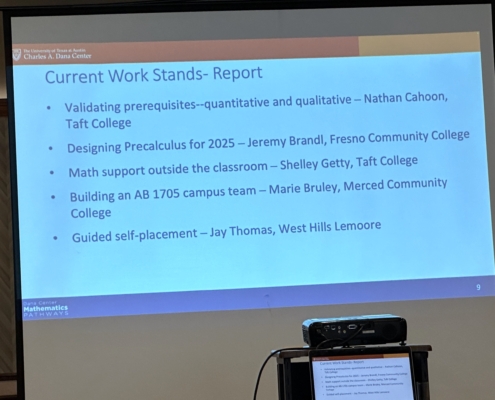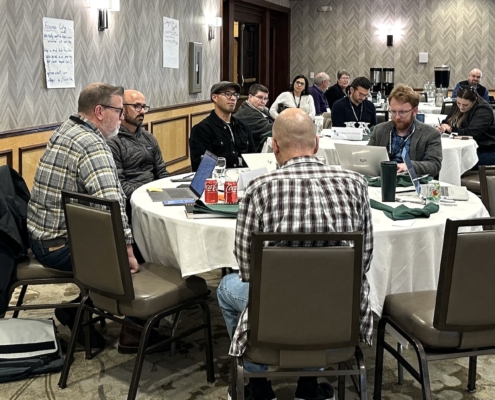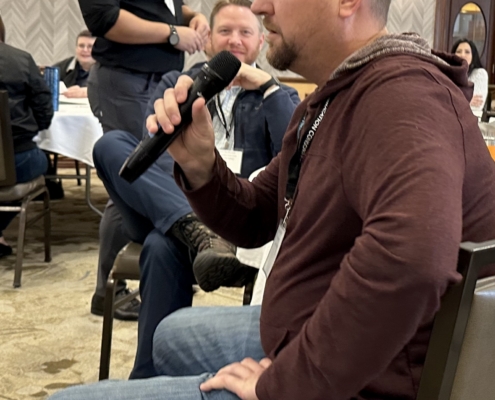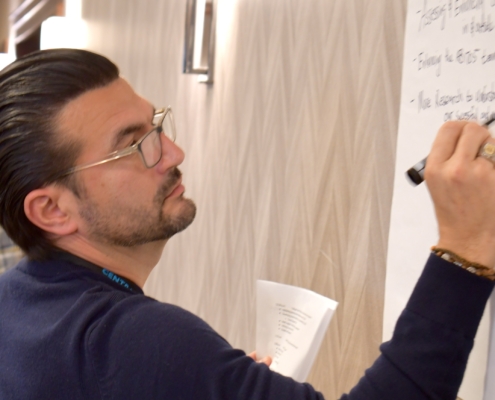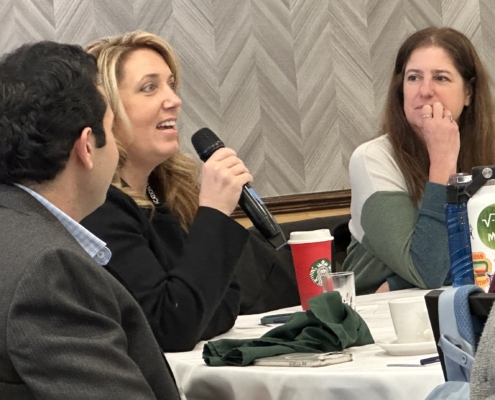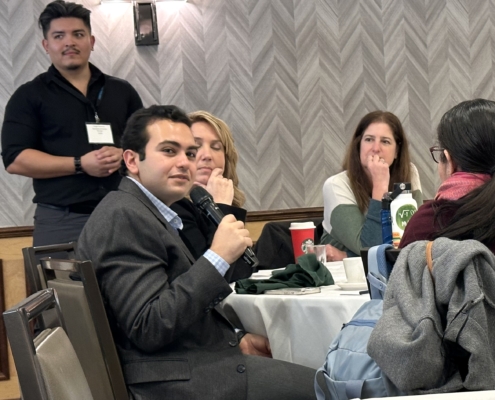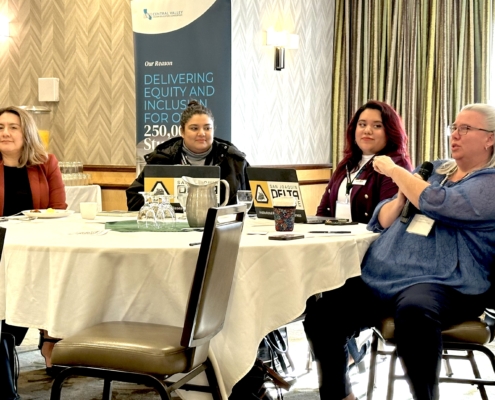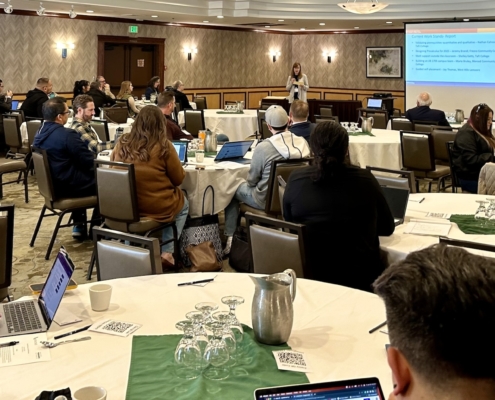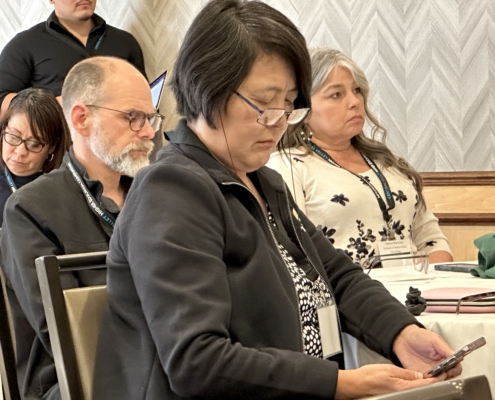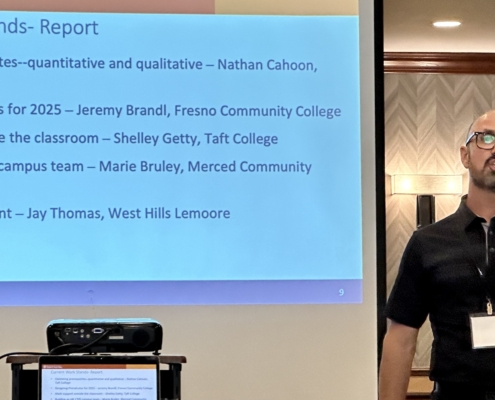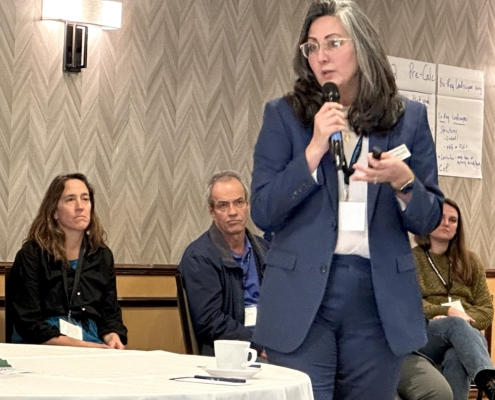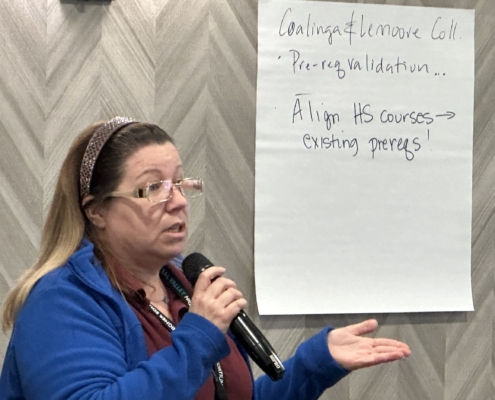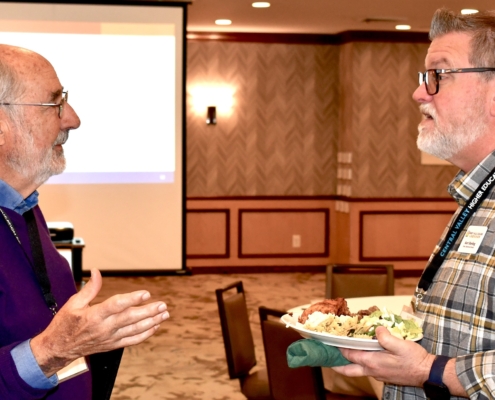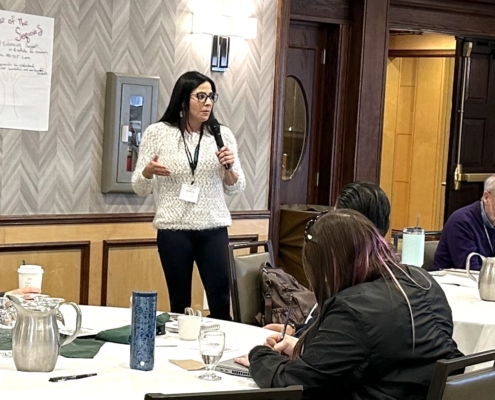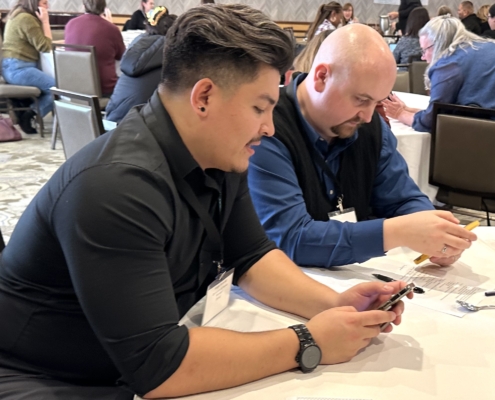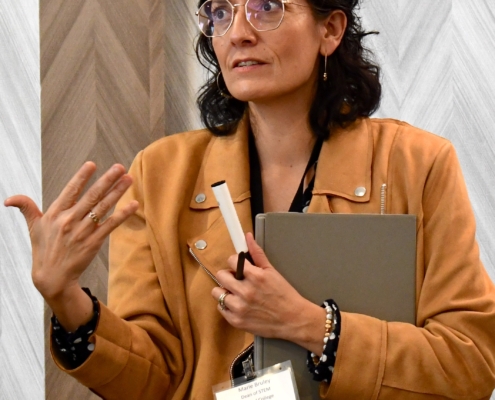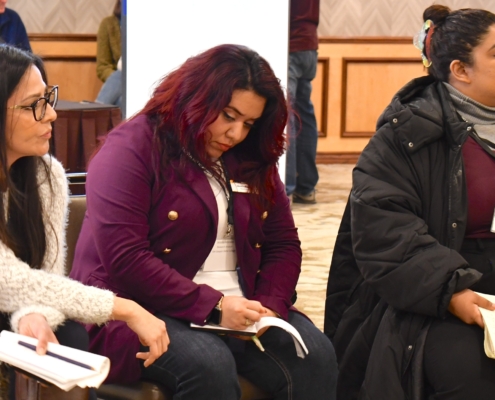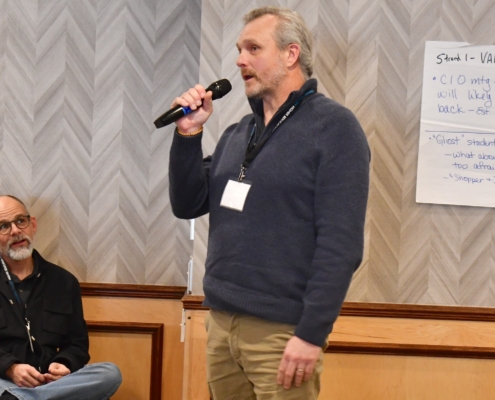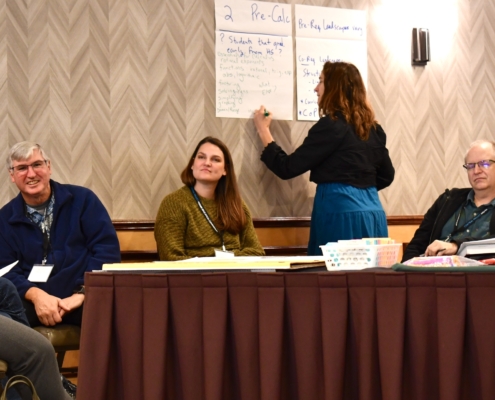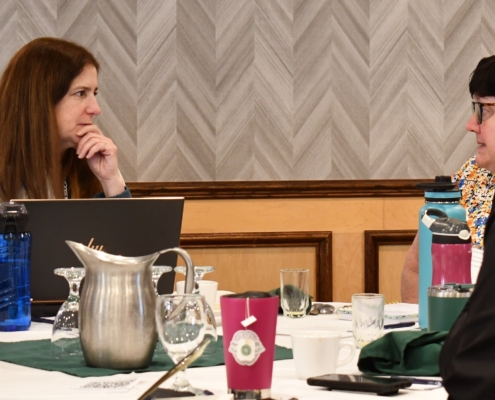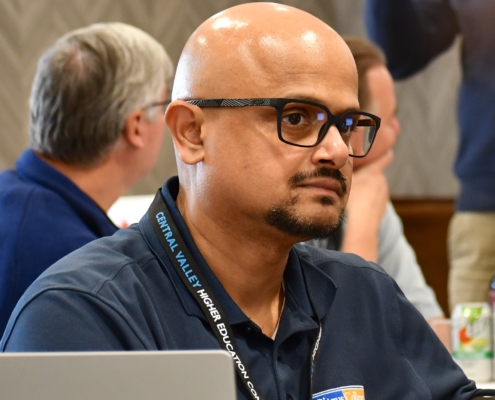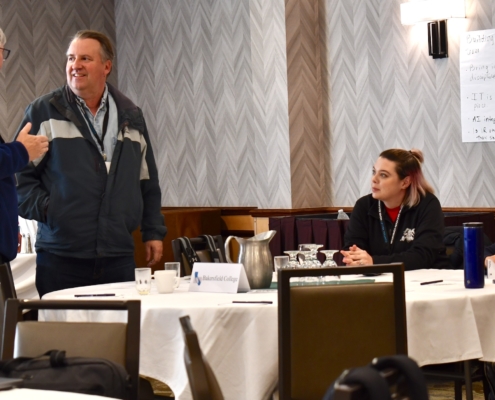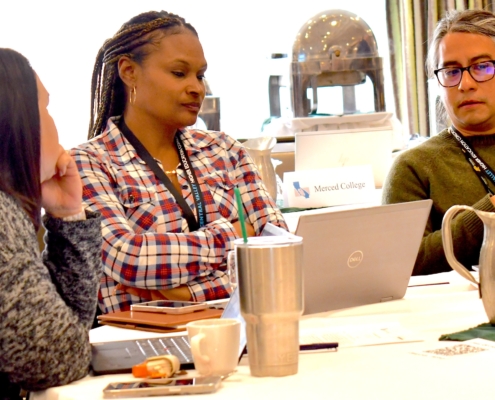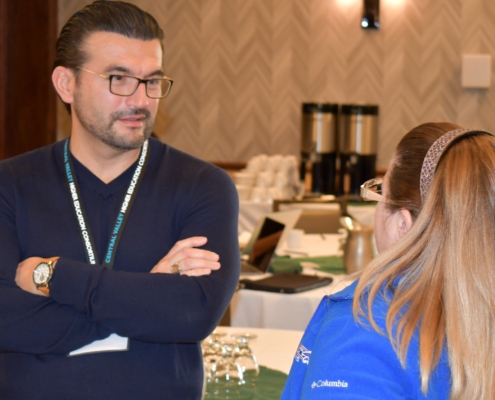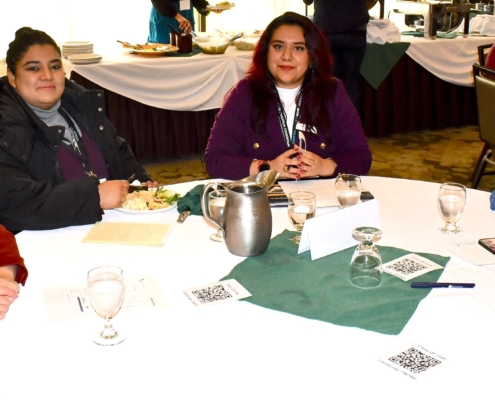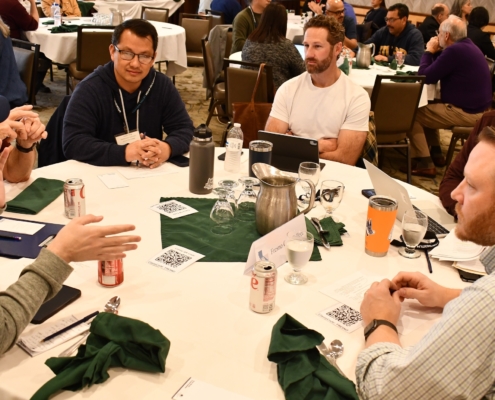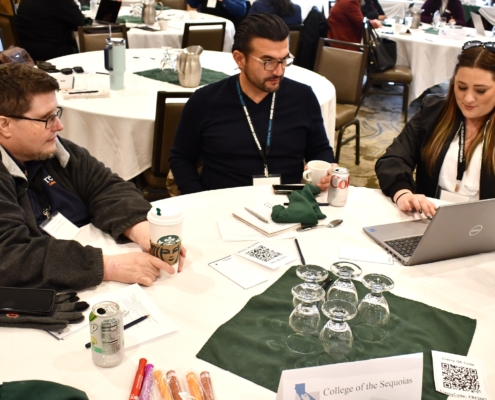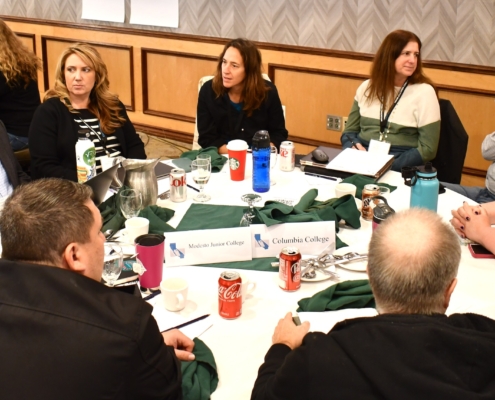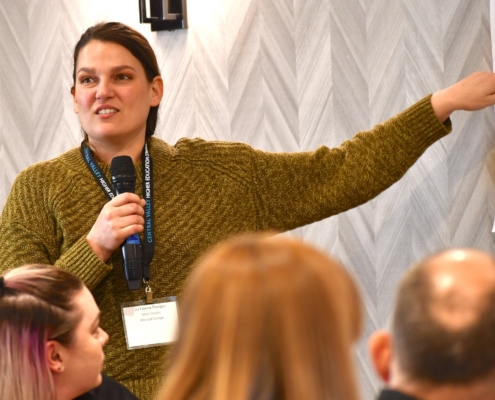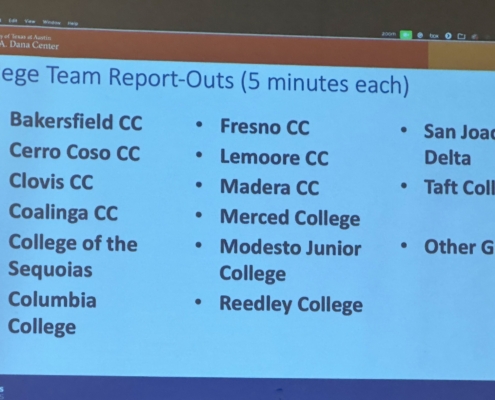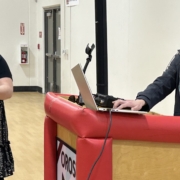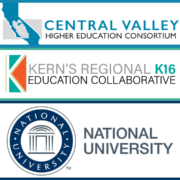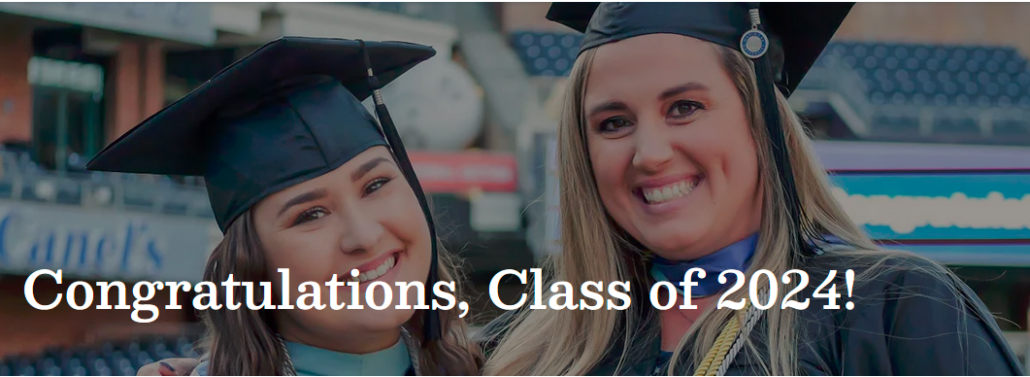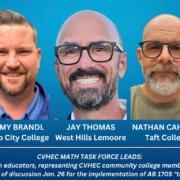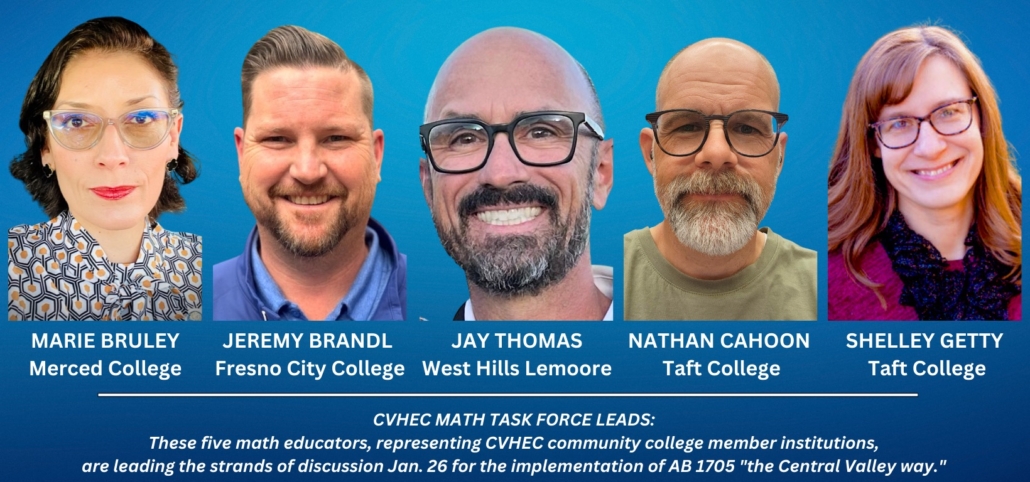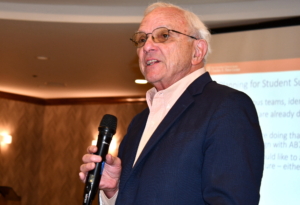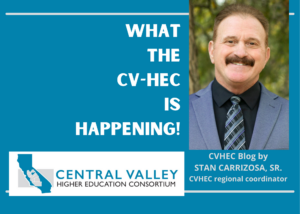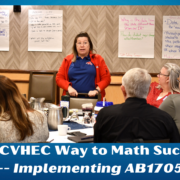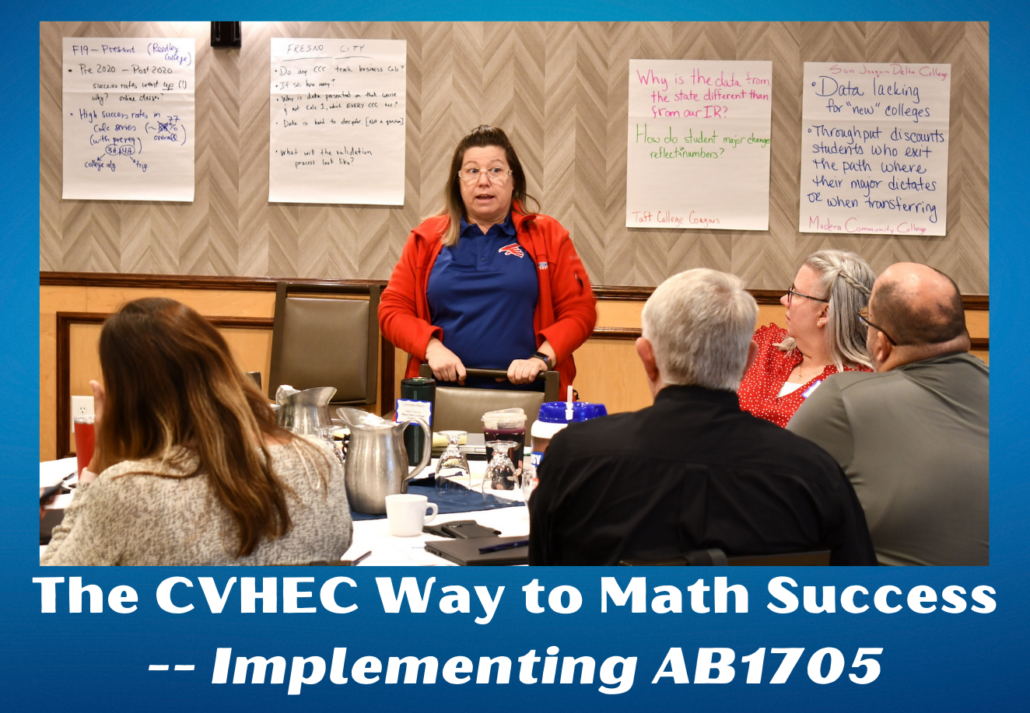WHAT THE CV-HEC IS HAPPENING BLOG (Summer 2024): Why some colleges are worth it
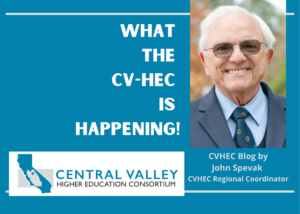 In the “What the CV-HEC is Happening” Blog for our summer 2024 special edition, Dr. John Spevak presents an observation about the value of a higher education. Dr. Spevak, who is a vice president-emeritus of Merced College and currently a regional coordinator for CVHEC, coordinates the English and Math Task Forces for the consortium — all champions for student support through such measures as dual enrollment. Through the consortium task forces, the former English teacher and college administrator continues to work closely with educators in the field for the educational advancement of students.
In the “What the CV-HEC is Happening” Blog for our summer 2024 special edition, Dr. John Spevak presents an observation about the value of a higher education. Dr. Spevak, who is a vice president-emeritus of Merced College and currently a regional coordinator for CVHEC, coordinates the English and Math Task Forces for the consortium — all champions for student support through such measures as dual enrollment. Through the consortium task forces, the former English teacher and college administrator continues to work closely with educators in the field for the educational advancement of students.
Higher ed is still a good
investment … and attainable
BY DR. JOHN SPEVAK
CVHEC Regional Coordinator
Vice President-Emeritus – Merced College
According to the results of a recent poll by Gallup and the Lumina Foundation, Americans are losing faith in the value of a college education.
Overall, according to that poll as reported by the Associated Press, only 36 percent of adults say they have a “great deal” or “quite a lot” of confidence in higher education. What’s worse, the poll shows that 32 percent of Americans have little or no confidence in a college education.
That’s both misleading and misguided.
For one thing “college” can mean different things to different people. For another, having a degree from the right college can make a big difference in a person’s opportunity and income.
By “right college,” I don’t mean a prestigious private college. A right college often means, especially in California, a two-year community college, a state university, or a small private college which provides significant financial aid.
A two-year community college degree or a certificate of completion is indeed “college.” That degree or certificate can be very valuable, especially if it’s a career-technical program that’s in demand and pays well, like nursing or welding.
A four-year degree can be even more valuable, especially in fields like communications, business, health, information technology and engineering– to name a few. Their lifetime earnings are significantly higher than those with a degree.
As the Associated Press article pointed out, “For those who forgo college, it often means lower lifetime earnings, 75 percent less compared with those who get bachelor’s degrees, according to Georgetown University’s Center on Education and the Workforce. And during an economic downturn, those without degrees are more likely to lose jobs.”
One of the reasons many Americans are doubting the worth of a college education is the debt often incurred in getting one. As one person interviewed in the AP article put it, “You graduate out of college, you’re up to eyeballs in debt, you can’t get a job, then you can’t pay it off.
What’s the point?”
It’s true that many people over the past decades have incurred a significant debt from student loans, which is exacerbated by the exorbitant interest charged for these loans. I know several people who have long ago paid off the principal of their student loans but are still paying and paying the interest.
However — and this had to be noted, known and understood — a person today can get a college degree without going into significant debt. The cost, for example, of attending a California community college these days in terms of tuition (also known as enrollment fees) is often zero.
Many California community colleges are also working at reducing the cost of books by providing what’s called “open educational resources,” essentially free online textbooks, often created by the college’s faculty members.
Attending a California public university or small private college can also be financially available to most Californians, especially if they begin with a two-year associates transfer degree and then follow a plan of courses that get them to the bachelor’s degree in no more than two additional years.
I’m tired of so many Americans of all backgrounds thinking of “college” as only prestigious private institutions that charge $150,000 or much more for a four-year tuition. Those universities often have value for those who can afford it or who receive full scholarships. But the vast majority of people can’t afford that amount and can’t afford to take out loans to pay for it.
“College” for most people should not be an expensive private institution. If it were, I would also wonder if a college education was worth it. However, “college,” in California and especially in the Central Valley, is accessible, affordable and worth it.
Instead of young people (and their parents) asking, “Can I afford college,” I wish they would ask, “What are my college options? What are the real costs, not just according to pundits on TV or social media, but according to the colleges themselves.”
College personnel, more than ever, are ready and willing to talk with prospective students of all ages and the parents of younger students about the real cost of a college education. And they are also ready and willing to show prospective students the extensive personal help they will receive to succeed in courses and earn their degree.
Often television and social media pundits who say college is not worth it are people who themselves have benefited from a college education. There’s some hypocrisy in that.
It’s true that there are many hard-working Americans without a college degree who can support themselves and their families, but the odds of most people doing this are long.
In California’s Central Valley, where the median family income is below the national average, it’s especially important to dispel the myth that college is not worth it. A two-year or four-year college degree is one of the best ways to achieve an income that will sustain families — enable them to pay rent or a mortgage, purchase a reliable car, buy clothes and put food on the table.
Central Valley colleges from Stockton to Bakersfield are working harder than ever to show students the value of a college education and to streamline the paths to a degree.
Community colleges in the valley, for example, are offering more dual enrollment courses than ever where students can earn college credits in high school, which reduces their time to a college degree.
These dual enrollment courses can be taken by most high school students, not just those students who in the past were steered into advanced placement (AP) courses. Community colleges are also working harder than ever, in collaboration with their high school partners, to provide the academic support needed to successfully complete dual enrollment courses.
In addition, many Central Valley community colleges, including Merced College, are partnering with the University of California Merced and local California State University campuses to provide user-friendly guides or “maps” to students and their parents. “Pathways Program Mapper” is a tool these colleges have developed that is available to anyone with a cell phone (no login or password required).
PPM will show a student what degree is needed to enter a particular career (for example, biology, business, engineering, etc.), what range of salaries people in those careers earn and then provide a map of courses from the first semester at a community college to the last semester at a university to attain that degree in the shortest possible time.
So, please, pundits, stop telling people that a college education isn’t worth it. Moreover, I hope readers of this column spread the word that here in the Central Valley a college education is not only worth it, but it’s attainable for anyone willing to pursue it.
John Spevak’s email is john.spevak@gmail.com.
Math Task Force continues AB 1705 work with April 19 convening
Secondary education voices invited to join discussion
Discussions to improve calculus pathways for STEM students amidst a pending deadline this summer continues with the third “Central Valley Way to AB1705 Success” Convening set for Friday, April 19 in Fresno that will also bring more secondary education voices to the table and a review of guidance issued by the California Community College Chancellors Office last month.
Registration is now open for the event in Fresno presented by the Central Valley Higher Education Consortium Math Task Force with the Charles A. Dana Center (University of Texas at Austin) from 9 a.m. to 3 p.m. at the DoubleTree by Hilton Hotel Fresno Convention Center, the site of two previous in-person convenings last fall and in January.
The event will re-convene community college math educators, administrators and institutional researchers working since the fall towards compliance with the final stage of AB1705: validation of equitable placement, support and completion practices for STEM programs.
Signed into law by Gov. Newsom in September 2022, AB 1705 is an amendment to the landmark legislation AB 705 (Irwin, 2017) which transformed placement and developmental education in the California Community Colleges. AB1705 supports full and comprehensive implementation by, among other requirements, specifying that colleges must demonstrate the benefit of transfer-level math preparatory courses for STEM Calculus 1 based on the following conditions:
- The student is highly unlikely to succeed in the first STEM calculus course without the additional transfer-level preparation.
- The enrollment will improve the student’s probability of completing the first STEM calculus course.
- The enrollment will improve the student’s persistence to and completion of the second calculus course in the STEM program, if a second calculus course is required.
From now until July 1, colleges have the opportunity to validate that their preparatory courses meet the aforementioned AB 1705 standards.
Since passage, the state’s community colleges have worked towards compliance of various aspects of AB1705 including 19 Central Valley community college members of CVHEC through representatives serving on the consortium’s Math Task Force consisting of math faculty and administrators.
The task force has held several virtual and in-person work sessions since October designed to collaborate in unity for compliance. At the last convening Jan. 26, more than 82 math and administrative representatives from the community colleges — including several campus research professionals — and one high school principal met with the task force to explore five strands of curriculum planning:
- Validating Prerequisites;
- Designing Precalculus for 2025;
- Math Support Outside and Inside the Classroom;
- Building an AB 1705 Campus Team; and
- Guided Self-Placement.
Since the Jan. 26 meeting, the strand leads have been preparing summaries of their breakout discussions held that day, said Dr. John Spevak, CVHEC regional coordinator who oversees the consortium’s Math Task Force.
Member college teams are also preparing summaries of the tentative plans they developed in the afternoon breakout sessions for oral reports. Additionally, the workgroups have been meeting and will report out on their progress in April regarding the strands.
A good portion of the April 19 meeting will be devoted to the data collection underway by CVHEC community college research professionals related to student success in math, part of the valleywide Data Collection Project under development by the consortium, said Spevak, who will again co-facilitate the April event with Dana Center colleague Dr. Tammi Perez-Rice.
Secondary ed voices
This next convening will also include representatives of K-12 school districts, including several high school principals who have already worked with CVHEC through the Central Valley Math Bridge Program.
“It’s important to bring into the conversation high school leaders and our colleagues who care as much about the future math success of students as community college math educators do,” said Dr. Benjamín Durán, CVHEC executive director.
That conversation was begun at the January convening of community college math professors and administrators when Marlena Celaya, principal of Orosi High School and former high school math teacher, told the group that Central Valley high school educators would very much like to participate in future discussions about math success for Central Valley students.
Spevak said this development will also foster additional learning about the high school math landscape as it pertains to college readiness.
Any Central Valley secondary education officials interested in attending the April 19 convening are welcome, he added.
CCC ‘validation memo’
Also up for discussion will be a Feb. 27 validation memorandum by the California Community College Chancellors Office entitled AB 1705 Validation of Equitable Placement, Support and Completion Practices for STEM Programs.
The Chancellor’s Office also presented a webinar March 4 to further discuss the details of this guidance and address questions.
The Dana Center and CVHEC teams are presently reviewing the CCC memo to provide analysis that will help guide the Math Task Force’s five strands committees and will be presenting its memo assessment in the coming weeks, said Joan Zoellner, M.A., who is the lead for the Dana Center’s Launch Years Initiative;
In a preliminary review of the memo, Zoellner noted that while the CCC memo provides direction on the validation process for transfer level math placement and enrollment practices for STEM programs, it indicates that no more than one transfer-level prerequisite shall be offered prior to calculus.
“The options for that prerequisite course are limited by the memo and validation options as well,” Zoellner said.
She recommended that consortium community colleges review the chancellor’s office memo and some of the findings presented to determine how it affects their respective campus.
“If possible, work with your IR department to confirm those numbers and results prior to the April 19 convening,” Zoellner advises.
For more info: centralvalleyhec@gmail.com
For media inquiries: Tom Uribes – cvheccommunications@mail.fresnostate.edu (or text 559.348.3278).
See also:
- CCCCO Memo Feb. 27, 2024: AB 1705 Validation of Equitable Placement, Support and Completion Practices for STEM Programs
- CVHEC Math Task Force
- What is AB 705 and AB 1705?
- WHAT THE CV-HEC IS HAPPENING BLOG (October 2022): AB 1705 – What Does It Do?
- CCC Memos and Resources
- https://bit.ly/MTFconveneKSEE24
- Valley’s math ed experts unite to address AB 1705 challenge for student success
- The CVHEC Way to Math Success — Implementing AB1705
- Math Task Force begins discussion of AB1705 implementation – Nov. 17 next
CVHEC Math Task Force meets in-person Oct. 13 for AB 1705 follow-up - NEWS RELEASE – CVHEC Math Task Force: Impactful legislation (AB 1705) Convenings Oct. 6 & 13
- CVHEC Website Feature: Math Task Force Page
MATH TASK FORCE: ‘Something extraordinary’ (Jan. 26 wrap)
Modesto Junior College math professor Tina Akers-Porter discusses her strand group’s deliberations at “The Central Valley Way to AB1705 Success” Convening Jan. 26 where a call for a “principals task force” by Orosi High School Principal Marlena Celaya would bring more secondary education voices to the table.
‘Something extraordinary is happening in math in California’s Central Valley’
Math Task Force latest AB1705 session leads to calls
for more data, high school input, re-convene April 19
BY TOM URIBES
CVHEC Media/Communications Coordinator
Realizing that state guidance surrounding Assembly Bill 1705 remains elusive, valley community college math educators and officials forged ahead at “The Central Valley Way to AB1705 Success” convening Jan. 26 in Fresno with a determined and unified mindset to develop implementation plans that will serve the best interests of their students including a follow-up session set for April.
In addition, the Central Valley Higher Education Consortium (CVHEC) Math Task Force discussion centered around five strands of curriculum planning for implementation before the law goes into effect July 1, two aspects emerged at the lively day-long work session: the increased participation of institutional researchers for pertinent data-collecting and a call for a “principal’s task force” to bring upper secondary education voices to the table.
Presented by CVHEC, the convening — the latest in a series of deliberations since fall — was attended by 82 representatives from the consortium’s 19-member community colleges, one high school principal and campus research professionals.
They agreed to reconvene April 19 for reports on follow-up work that will occur as a result of this most recent event. Registration for that event will open next month with additional details forthcoming.
Facilitated by the Charles A. Dana Center at the University of Texas at Austin, the session last month reviewed five strands of curriculum planning: Validating Prerequisites; Designing Precalculus for 2025; Math Support Outside and Inside the Classroom; Building an AB 1705 Campus Team; and Guided Self-Placement.
“With tensions high and little guidance surrounding AB1705, the 19 community colleges and districts that comprise the CVHEC nine-county region are rolling up their sleeves and getting to work on this math movement the ‘Central Valley Way’,” summarized Tammi Perez-Rice of the Dana Center.
Perez-Rice, who co-facilitated the event, said the convening was solely dedicated to working and planning at a regional and institutional level in two parts. The first part was dedicated to expanding the five work groups that emerged from the Nov. 17 webinar and creating a plan to move forward. The second half of the convening was devoted to institutional planning.
“The fruits produced from these convenings are already being felt around the region,” Perez-Rice said. “The plans and implementations emerging from these convenings are more than just a response to AB705 and AB1705; they cultivate systemic reforms that will benefit all students in the CVHEC region and beyond.”
John Spevak, CVHEC regional coordinator who oversees the consortium’s Math Task Force and co-facilitator of the Jan. 26 gathering, said in the short-term, the five strands work groups will continue to communicate and provide updates in preparation for the April 19 convening. The strand leads are preparing summaries of their Jan. 26 breakout discussions and member college teams are preparing summaries of the tentative plans they developed in the afternoon breakout sessions for oral reports in April.
“In the longer term, our Math Task Force will continue to monitor what the California Community College Chancellor’s Office says, while mainly going forward with our own Central Valley approach to the five strands.”
That “Central Valley Way” stems from the work undertaken by the CVHEC Math task Force, first formed in 2019, in the past year that was intensified with four work sessions beginning Oct. 6 in a virtual convening with CCC vice-chancellor Eric Cooper. The first in-person session followed Oct. 13 in Fresno and another virtual session was held in two parts Nov. 17 before the Jan. 26 session.
These sessions may represent the only concerted effort by a region’s community college math community actively meeting to collaborate across campus boundaries for ways to unite as one voice and determine a curriculum course of action that meets the law’s intent, Spevak said.
“We at CVHEC, along with the Dana Center representatives and our College Bridge partners in the Math Bridge Program, feel that something extraordinary is happening in math in the Central Valley of California,” Spevak said.
After the Jan. 26 session ended, Perez-Rice reiterated a point she made the first time she visited Fresno for the first in-person convening last fall:
“This collaboration today was amazing. As I travel and talk to math faculty all over the country, what I see pulsating from the CVHEC community here in Central California is just compassion; caring about their students; putting their students first; understanding what their students need; and more importantly collaborating with each other working across institutions to make things happen.”
Inviting secondary ed voices to ‘align syllabi’
A key development of the convening was the assertion and agreement that a crucial next step is “to involve high schools in the discussion and determine how to breakdown barriers between systems for a cohesive collaborative effort to put students first across the state of California,” a message delivered by Marlena Celaya, principal of Orosi High School who was the only secondary education official in attendance.
Celaya’s comments, first in a strand session and later in general comments before the assembled group, resonated with the community college professionals as she offered to lead a task force of principals/administrators who would unify with the CVHEC community college math educators for implementation strategy — to listen and hear what the needs are and how to meet those needs.
“I’m willing to lead this work because I don’t want people to go through the wars I went through teaching algebra and volunteering all my time,” said Celaya, a former math teacher at Dinuba High School. “We would want to hear from community colleges and say to them ‘what do you need?’
“We heard something from you today: ‘I want to know what courses are offered at the high school and what does that course description look like?’ Aligning syllabi is what I’d like to do,” Celaya said. “Mathematics is my passion.”
Perez-Rice said the April 19 convening promises more high school representation, with over twelve principals who are part of the Math Bridge Program by CVHEC and College Bridge being invited. Other secondary education officials from throughout the valley are welcome she said.
Participant feedback: ‘great to see we’re not alone in this …’
After the event, several participants shared their assessment of the Jan. 26 convening.
“The conversations were amazing and we really appreciated being here,” said Joshua Lewis, chair of the Bakersfield College Mathematics Dept.
“There have been so many legislative changes and so many unknowns it’s nice to see the work that other campuses are doing and realize that we’re not alone, that we have shared values; that we have shared emphasis on student learning and really care about doing right by all of our students,” he added.
Nathan Cahoon, Taft college math professor, felt that the efforts of CVHEC’s Math Task Force as exhibited at the convening is strengthening the voice of the valley’s math community which will have an impact.
“It was amazing to work with incredible professionals who have some really amazing ideas,” he said. “I know I took many good notes about ideas to implement at our college. The connections we are building here with each other will be powerful down the road as we build a cohesive effort to get some good research together that we can send to the state as one voice from all the colleges.”
Modesto Junior College math professor Marina Hernandez said coming together within the region is relished because when attending other statewide or national conferences, the focus is not as localized.
“It was very helpful to learn what other colleges in the Central Valley are doing because we share similar student population and resources characteristics and their best practices are applicable to us here in our region,” Hernandez said.
Tina Akers-Porter, Modesto Junior College math professor, said the Math Task Force work has helped her better understand what AB1705 is and what it means for her students.
“I feel like I have a better understanding of some of the challenges of the legislation and what others are worried about,” she said. “We share some of those worries but it’s great to hear different points of view on that. A byproduct of this is we are seeing how we need to support underprepared students more, inside and outside the classroom, and sharing ideas to do that.”
Shelly Getty, Taft college math faculty and a strand leader, echoed Akers-Porter: “We left knowing we are going to start some specific tutoring and targeting students for tutoring. We will try to advertise it better and recruit so students get more access to the services we already provide which will greatly impact them. We shared some good ideas on how to do that effectively.”
Marissa Martinez, Taft college math professor, said, “We have our work cut out for us. There’s a lot of things that we have to address with a lot of moving parts. Everything keeps changing but it was great to be able to see that we’re not alone in this, that we’re working together to better serve our students.”
She said this intercollegial collaboration and the feedback from the colleges helps “so we don’t have to reinvent the wheel — what worked, what didn’t work.”
Next steps? Data research
“I would say the next step is collecting our data to see how the numbers show where we are so we can prove that these courses are important for our student success,” Martinez said.
This data aspect was also a key part of the convening as institutional research professionals were invited and directly participated such as Arooj Rizvi, research analyst in the Office of Institutional research and Effectiveness at San Joaquin Delta College.
“Researchers have a monumental role in the implementation of AB 1705 because policymakers are going to depend a lot on what we are able to produce as a group or even as an institution,” Rizvi said. “Being a part of these conversations helps us to see the bigger picture, the context and the requirements of what exactly it is that we are looking for in the data.”
She said it was exciting to hear at the convening what area colleges are going through.
“I realized how similar our challenges are from institution to institution, “she said. “Working through that together and being solution-oriented is something that’s going to take all of us towards a beneficial direction. Seeing us all here today was a defining moment in history.”
Owynn Lancaster, vice president of academic strategy for CVHEC partner College Bridge, said the event was “a huge success seeing folks come together from math to talk about math and really pool their resources to address actual challenges.
“The most powerful focus of change in education is always the educator,” Lancaster said. “I know everything’s heaped on them but in a lot of ways they have the greatest power of the greatest agency for this.”
For more info: centralvalleyhec@gmail.com
For CVHEC media inquiries: Tom Uribes – cvheccommunications@mail.fresnostate.edu (or text 559.348.3278).
See also:
https://bit.ly/MTFconveneKSEE24
Valley’s math ed experts unite to address AB 1705 challenge for student success
The CVHEC Way to Math Success — Implementing AB1705
Math Task Force begins discussion of AB1705 implementation – Nov. 17 next
CVHEC Math Task Force meets in-person Oct. 13 for AB 1705 follow-up
NEWS RELEASE – CVHEC Math Task Force: Impactful legislation (AB 1705) Convenings Oct. 6 & 13
CVHEC Website Feature: Math Task Force Page
PHOTO GALLERY
Kern Master’s Upskilling Program: 2nd cohort graduates – next cohort recruitment underway
Two cohorts from the Kern Master’s Upskilling Program (MA English) are eligible to participate and walk in the 2024 National University Commencement May 18 at Petco Park in San Diego. The program’s high school teacher participants are now qualified to teach English dual enrollment community college courses on their respective campuses. A third English cohort and the first Kern math cohort graduate in June.
Kern Master’s Upskilling Program
reaches another milestone
Second English cohort graduation – recruitment underway for a fall math cohort
The Kern Master’s Upskilling Program for high school teachers seeking a master’s degree in English or Math that qualifies them to teach dual enrollment courses at their respective campuses reached its second milestone last month when 11 participants completed post-baccalaureate requirements in English through National University.
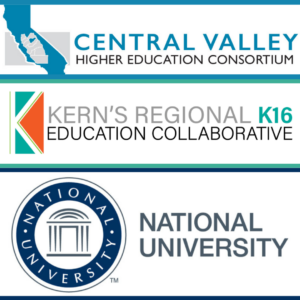 Formally known as the Dual Enrollment Teacher Upskilling Pathway for English and Mathematics, the Central Valley Higher Education Consortium initiative is in partnership with the Kern Regional K-16 Education Collaborative that was funded as part of an $18 million statewide competitive grant in June 2022 to improve student progress from high school to postsecondary education and ultimately into the workforce.
Formally known as the Dual Enrollment Teacher Upskilling Pathway for English and Mathematics, the Central Valley Higher Education Consortium initiative is in partnership with the Kern Regional K-16 Education Collaborative that was funded as part of an $18 million statewide competitive grant in June 2022 to improve student progress from high school to postsecondary education and ultimately into the workforce.
The program also announced recruitment is underway for a third math cohort of 21 students to begin this fall for completion in spring 2026 though Fresno Pacific University in concert with the Kern County Superintendent of Schools (KCSOS), which serves as the administrative agent for the Kern K-16 Collaborative.
Informational meetings are set for March 21 and April 11 at 4:30 p.m.
A potential fourth English cohort pilot through CSU, Bakersfield with seven students is also in the works said Tom Burke, CVHEC’s Kern Masters Upskilling Program lead who reports that the program progress “has been very good” since it was funded two years ago.
“With the first two cohorts of English graduates to be joined by our first cohort of math graduates this summer, we are well on the way to significantly increasing the number of faculty in Kern County eligible to teach dual enrollment or community college courses in math and English,” Burke said.
The January graduation follows the first cohort of 11 English students who graduated in September for the innovative state-funded CVHEC initiative that helps reduce the cost of tuition for high school teachers to pursue a master’s degree, a state requirement to teach community college dual enrollment courses.
Each NU cohort group of students is eligible to participate and walk in the 2024 Commencement services set for Saturday, May 18, at Petco Park in San Diego, said Jessica Gladney, senior director for Partnership Development/ Workforce Education Solutions for National University,
The first Kern Master’s Upskilling Program cohort — MA, English with a specialization in Rhetoric — began in January 2023 with 13 out of 15 students completing their program in November 2023 (nine of the 13 will graduate with honors with a grade point average of 3.85 and above).
The two remaining students are currently in the process of completing their capstone, which is the culminating course of the master’s program, Gladney said.
The second Kern Master’s Upskilling Program cohort of MA, English with a specialization in Rhetoric, began in March 2023, and 10 out of 15 students completed their program in January 2024. The remaining students are currently in the process of completing their capstone course, Gladney reports.
She said each NU cohort group of students is eligible to participate and walk in the 2024 Commencement services set for Saturday, May 18, at Petco Park in San Diego.
“We are proud of these candidates and we are excited to assist with building a qualified candidate pool of eligible dual-enrollment English teachers to meet the workforce demands in the Central Valley,” Gladney said.
CVHEC, made up of 28 institutions of higher education in the valley’s nine-county region from San Joaquin to Kern counties, is one of several partners in the Kern Collaborative.
South Valley CVHEC members include California State University, Bakersfield; Kern Community College District; Bakersfield College; Cerro Coso College; Taft College; Porterville College; Fresno Pacific University; and National University.
The project also includes the CVHEC Mentor Program that pairs the master’s candidates with a community college mentor to support them along the way and help them navigate the process to becoming an adjunct community college faculty member.
Under coordinators Dr. Liz Rozell (math) and Dr. Vikash Lakhani (English), the program is still accepting community college professors to serve as mentors, Burke said.
For more details about the fall 2024 math cohort through Fresno Pacific, potential students can contact:
- Manjula Joseph, program director – manjula.joseph@fresno.edu or 559.453.2096
- Nathan Lyness, senior Outreach & Admissions representative – nathan.lyness@fresno.edu or 559.453.7183
See:
- CVHEC Teacher Upskilling Program for Master’s Degrees Supports Dual Enrollment in South Valley via Kern K-16 Collaborative Grant (June 23, 2022)
- Rozell, Lakhani Named CVHEC’s Kern Faculty Mentor Coordinators (February 22, 2023)
- CVHEC IN THE NEWS: KBAK features Kern Master’s Upskill Program (November 17, 2022)
- Tom Burke Named Kern Master’s Upskill Lead (November 16, 2022)
- Herrera to Head Kern Regional K-16 Education Collaborative (July 13, 2022)
- KCSOS Mary Barlow Announces $18.1M Workforce Grant (KCSOS press release – June 9, 2022)
- “Blurring the Lines Between High School and College: Dual Enrollment in the Central Valley”(CVHEC video – March 2022)
Valley’s math ed experts unite to address AB 1705 challenge for student success
Math Task Force Convening Jan. 26:
‘Central Valley Way To AB1705 Success’
With the agenda released this week, over 60 Central Valley math education experts will convene in Fresno Jan. 26 to plan math pathways for student success as they brainstorm within five strands of implementation around Assembly Bill 1705 that goes into effect this summer.
The Central Valley Higher Education Consortium’s “Central Valley Way To AB1705 Success” Convening from 9 a.m. – 3 p.m. at the DoubleTree by Hilton Hotel Fresno Convention Center, will bring together community college math educators, administrators and institutional researchers.
Presented by the CVHEC Math Task Force and facilitated by the Charles A. Dana Center at the University of Texas at Austin, the convening is free with advance registration and includes lunch.
Discussion for the historic convening — with administrators and IR experts joining in the conversation — will center around five strands that the region’s community college math academicians can undertake for student success when the new law goes into effect July 1: Validating Prerequisites; Designing Precalculus for 2025; Math Support Outside and Inside the Classroom; Building an AB 1705 Campus Team; and Guided Self-Placement.
Five Math Task Force members serving as strand leads are: Jeremy Brandl, Fresno City College math professor; Nathan Cahoon and Shelley Getty, both Taft College math professors; Marie Bruley, Merced College dean of Science, Technology, Engineering, and Math (STEM); and Jay Thomas, West Hills College Lemoore math professor.
After the event opens with a welcome and brief introductions, the strand subcommittees open the discussion by presenting reports regarding preliminary strand deliberations over the past few months that started at three meetings the Math Task Force held in the fall.
Participants will then break into tabletop talks for feedback and to brainstorm new ideas, a timeline and next steps followed by report outs of those subcommittee sessions.
Following lunch, the participants will break into their respective college teams to discuss “Preliminary College Plans” in two parts: “Validating Prerequisites Between Now and July 1, 2024;” and “Developing New/Revised Curriculum to Take Effect July 1, 2025.”
“College Team Report Outs” will follow before the final session “Where Do We Go From Here?” looks towards the future and the role of Math Task Force sub-committees, college teams and CVHEC.
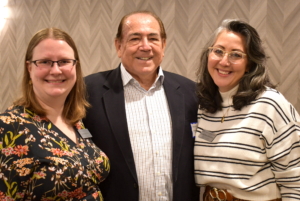
Dr. Benjamín Durán of CVHEC with Dana Center reps Joan Zoellner and Tammi Perez-Rice at the Oct. 13 Math Task Force convening in Fresno.
Dr. Benjamín Durán, CVHEC executive director, said, “We are proud that our Central Valley community colleges are leaning in on the expertise of their own math experts to figure out the best way to support our students within the guidelines of the legislation.”
AB 1705 — passed in 2022 for implementation July 1, 2024 — expands the provisions established in AB 705 (2017) by explicitly requiring community colleges not only to place students directly into transfer-level English and math courses but also to ensure that students actually enroll in those courses.
The legislation also establishes that for students who need or desire extra academic support, community colleges shall provide access to such support. The new law clarifies that a community college can require students to enroll in additional concurrent support if it is determined that the support will increase the student’s likelihood of passing transfer-level English or math.
Community colleges have been tasked with ensuring they comply with both AB705 and AB1705 designed to strengthen support for student success and increase degree completion.
CVHEC helped start the conversation by bringing together its Math Task Force — made up of representatives from CVHEC community colleges — and other math educators to discuss ideas and options regarding implementation within the Central Valley community college mathematics community last fall.
In three virtual sessions and one in-person convening in 2023, the Math Task Force created a collaborative “Central Valley Approach” to each, said Dr. John Spevak, CVHEC regional coordinator who oversees the consortium’s Math and English Task Forces.
“Now, for the January session, administrators and researchers are joining the Math Task Force to develop data-driven and college-endorsed solutions that help meet the challenge head on and in unity for the best interests of students.”
The fall inaugural sessions were facilitated by two Dana Center representatives who will return to Fresno for the Jan. 26 convening: Joan Zoellner, M.A., who is the lead for the Dana Center’s Launch Years Initiative; and Dr. Tammi Perez-Rice, Postsecondary Course Program specialist.
Dr. Erik Cooper, assistant vice chancellor of the California Community College Chancellor’s Office Cooper, also participated in the first virtual session to discuss the recent history of math education reform in California and answer questions as well as present the CCCCO’s AB 1705 Implementation Guide and FAQ webpage.
“With the passage of AB 705 then later 1705 – all designed to strengthen support for student success – CVHEC has been moving full steam ahead in assuring that our member colleges and their feeder high schools have a good understanding of the seemingly turbulent waters of the legislation,” Durán said.
Strand breakdown:
- Validating prerequisites — quantitative and qualitative: creating a Central Valley collaborative approach which would help make a strong case with the state. Point person: NATHAN CAHOON, Taft College math professor.
- Designing Precalculus for 2025: An effective single-course prerequisite for Calculus 1 (especially valuable if the state allows in 2025-26 only one prerequisite course for Calculus 1). Point person: JEREMY BRANDL, Fresno City College math professor.
- Math support outside and inside the classroom: What’s working best in the Central Valley, including math lab centers, tutoring, embedded tutoring, supplemental instruction, etc. Point person: SHELLEY GETTY, Taft College math professor.
- Building an AB 1705 campus team: Who needs to be on the team? Math and English professors, IR/IT staff, counselors, administrators, etc. How does it best function? Point person: MARIE BRULEY, Merced College dean of Science, Technology, Engineering, and Math (STEM).
- Guided self-placement: Helping ensure with the best possible questionnaire that students are taking the right math class when they start college. Point person: JAY THOMAS, West Hills College Lemoore math professor.
(Links to recordings of the two previous sessions are available below).
REGISTER – “The CVHEC Way to Math Success — Implementing AB1705” (Jan. 26, 2024)
EVENT AGENDA For questions: centralvalleyhec@gmail.com.
For media inquiries: Tom Uribes 559.348.3278 (text msg) or cvheccommunications@mail.fresnostate.edu
SEE:
- Previous sessions recordings:
CVHEC “AB1705 in the Central Valley” Webinar with Dr. Erik Cooper Oct. 6, 2023
MTF meeting Nov. 17 (10 a.m. session)
MTF meeting Nov. 17 (1 p.m. session)
- Coverage of the fall sessions:
Math Task Force begins discussion of AB1705 implementation – Nov. 17 next (with Oct. 13 photo gallery).
CVHEC Math Task Force meets in-person Oct. 13 for AB 1705 follow-up
NEWS RELEASE – CVHEC Math Task Force: Impactful legislation (AB 1705) Convenings Oct. 6 & 13
- The CCCCO’s AB 1705 Implementation Guideand FAQ webpage.
- The CVHEC Math Task Force
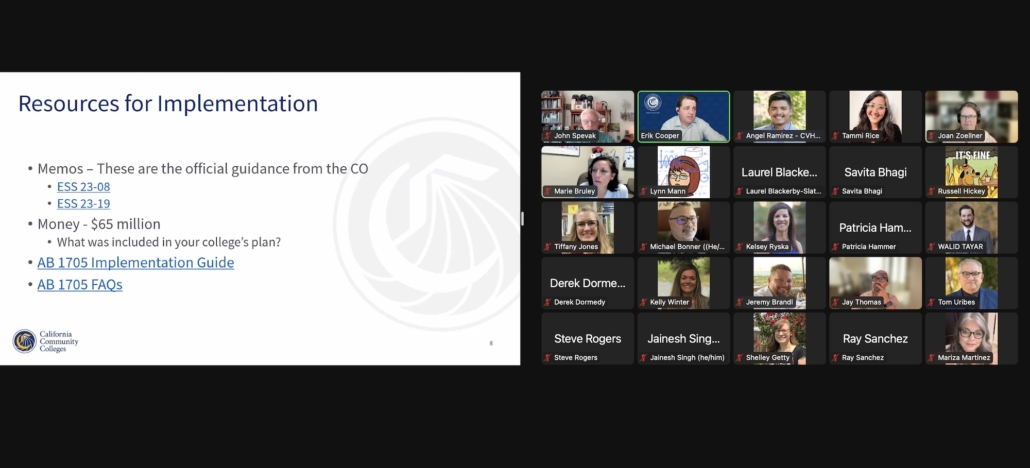
Dr. Erik Cooper of the California Community Colleges Chancellor’s Office zoomed into the Oct. 6 CVHEC Math Task Force session to address AB1705 implementation.
WHAT THE CV-HEC IS HAPPENING BLOG (January 2024): CVHEC 2023 — surging forward for Central Valley students
To kick off our 2024 “What the CV-HEC is Happening” Blogs, CVHEC Regional Coordinator Stan Carrizosa, Sr. follows up the year-in-review published in our December newsletter issue by offering a perspective of the consortium’s progress in 2023 that sets the stage for a productive new year. Carrizosa, who is president-emeritus of CVHEC member College of the Sequoias and an integral part of the CVHEC team, serves as the lead for the consortium’s Central Valley Transfer Project. The CVHEC blog features perspectives about the higher education community and issues. Submissions are welcome for consideration: Tom Uribes, cvheccommunications@mail.fresnostate.edu.
Propelling successfully, purposefully like a guided rocket
BY STAN A. CARRIZOSA, SR.
CVHEC Regional Coordinator
(President-emeritus, College of the Sequoias)
As a child, I remember watching a weekly science show called “The Undersea World of Jacques Cousteau” that explored the ocean and marine biology.
One fascinating episode depicted how an octopus at any moment could be moving wildly with all eight legs and not advance at all. But once the octopus contracted its core by simultaneously snapping all eight legs in the same direction, a burst of air coming from the fish propelled it successfully and purposefully through the water like a guided rocket.
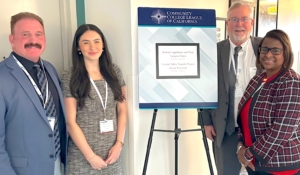
Stan Carrizosa, Sr. (left) and CVHEC Central Valley Transfer Project team partner Tom Burke presented at the Community Colleges League of California in November along with UC Merced grad student Araceli Tilley who discussed her success with the project’s Program Pathway Mapper software and Jennifer Johnson of the Foundation for California Community Colleges (right).
Over the course of the past 12 months, CVHEC has flexed its octopus legs and undertaken otherwise separate projects like Math Bridge and Master’s Upskilling (dual enrollment) and the Central Valley Transfer Project. By aligning them and their sub-parts, CVHEC has achieved the snapping of its octopus legs successfully surging us forward in the form of real achievement results for higher education in the Central Valley and for our region’s students specifically.
As we move into 2024, the work of CVHEC continues to be more aligned in ways that leverage each element and make the wholistic effort more cohesive and successful. This reminds me how effective it was to do this same thing as a college president. It was important to have clear goals and objectives and planned actions designed to address specific aspects of an issue to ensure greater success.
This past year, CVHEC acted like an organization with big-picture goals for improving student achievement region-wide and a measured plan of actions all designed to work together as a system to achieve success.
The two key drivers of this system for CVHEC success are strong intersegmental partnership commitments to:
- a robust dual enrollment;
- increasing successful community college transfers to higher education institutions.
Biggest DE challenge: qualified instructors
Armed with direct feedback from our first Dual Enrollment Summit held three years ago, we heard that one of the biggest challenges to implementing dual enrollment courses was the ability to find qualified instructors to teach college courses on high school campuses.
CVHEC responded by creating an upskilling project where high school teachers in math and English could earn a master’s degree in their content areas and be qualified to apply for and teach dual enrollment college courses on their high school campuses.
Early results from dual enrollment courses showed that students were more successful when the teacher for their college courses was a member of their regular high school faculty. Under the leadership of Dr. John Spevak, CVHEC regional coordinator and vice-president emeritus of Merced College, who facilitated an impressive package offering high school teachers the opportunity to earn a MA degree in their content areas through our partner universities, this opportunity had many residual benefits such as:
- improving the quality of teaching for their high school classes,
- earning higher salaries at their high school,
- creating a professional learning community between high school and community college teachers,
- and most importantly, changing teacher attitudes about the ability for high school students to succeed in college-level work.
The benefits for high school students are enormous.
Those enrolled in college dual enrollment courses experience pass rates of 80-plus percent while mainstream college students pass rates are in the 50 percent range. Finally, dual enrollment has proven to be a game-changer for first-generation college students in closing the equity gap among them and their college prep peers.
If students are able to take their college math and English courses before graduating high school, they start their college career on a level playing field by having completed their first required courses in transfer-level math and English. This enables them to get on the right pathway and stay straight toward their degree completion.
Incentivizing the efforts to increase transfers
The second key driver for CVHEC in 2023 and moving into the new year is the Central Valley Transfer Project!
The breakthrough moment in this project came when UC Merced agreed to review the CSU ADTs and approve these lower-division sequences as meeting the requirements for successful transfer to UCM. Central Valley CSU’s including Bakersfield and Stanislaus have bought in to the Transfer Project as well. Over the past three years CVHEC has worked to complete implementation in eight of our CV community colleges with three more joining the project this year.
Again the student benefit stands clear: early results show that students in the Transfer Project increase their percentages of on-path course completion each semester by 20 points to 80-plus percent. The same students also reduce their number of units to degree from a high of 85 down to 62.
Meanwhile the new statewide Student Funding Formula starts to provide enhanced per/FTES revenue for successful transfers to four-year institutions, further incentivizing the efforts to increase transfers.
We know that of all the successful graduates earning degrees from CSU’s, 50 percent started their education at a community college. Most recently, California Community Colleges Chancellor Dr. Sonya Christian unveiled her VISION 2030 which includes the Central Valley Transfer Project as a Demonstration Project for the entire state. As a result, CVHEC is now being recruited in both southern and northern California to share the success of the CV Transfer Project with those regions through presentations at various convenings.
Thoughtful and effective continuum creating unprecedented leverage for success
In summary, in addition to tracking and assessing our efforts as individual projects, it is equally if not more important to step back and see the bigger picture in the CVHEC body of work for 2023 that sets the stage for promising 2024. We can see there is a thoughtful and effective continuum that links these efforts together creating unprecedented leverage for success:
- CVHEC started by looking at the data and listening to the practitioners in the field to develop an agenda of work to support our colleges.
- Dual enrollment shows great promise but needs more qualified instructors.
- High school students in dual enrollment courses can close the equity gap between them and their peers thus advancing their personal confidence and capacity to succeed in college.
- Most higher ed students start in our community colleges and now through the Transfer Project they have a clear pathway of courses to take for a successful transfer to four-year universities.
- Once our community college students successfully complete their transfer, statistics show that they represent 50 percent of all university graduates.
So, looking back over the past 12 months, CVHEC – like the octopus snapping our legs to successfully surge forward – has successfully linked together major initiatives to build upon and strengthen each other allowing students to experience a continuum of effectiveness and success in achieving their higher education goals and objectives. To close out 2023 and look ahead, our executive director Dr. Benjamín Durán sums up the CVHEC spirit best in his newsletter director’s message published in our December issue:
“This year we are happy to salute and greet our K-12 partner districts who have joined us in creating meaningful pathways from middle school and high school to college. As we prepare to welcome 2024, stay tuned as we continue to nurture many roads leading to one destination – getting students to and through college in a timely manner!”
The CVHEC Way to Math Success — Implementing AB1705
Registration for “The CVHEC Way to Math Success — Implementing AB1705” set for Jan. 26, 2024 in Fresno is available here.
All math hands on deck!
Central Valley math, admin, IR pros invited to help plan for
AB1705 implementation at ‘The CVHEC Way to Math Success’ convening Jan. 26
A historic convening of the Central Valley’s mathematics professionals will be held in Fresno Jan. 26, 2024 to merge ideas stemming from a series of fall meetings of the Central Valley Higher Education Consortium Math Task Force designed to address implementation of AB 1705 in 2024.
Registration is now open for “The Central Valley Way To AB1705 Success” that will be held from 9 a.m. – 3 p.m. at the DoubleTree by Hilton Hotel Fresno Convention Center for math educators, administrators and institutional researchers. The event, facilitated by the Charles A. Dana Center at the University of Texas at Austin, is free with advance registration and will include lunch.
The convening continues a first-of-its kind year-long discussion of ideas and options within the Central Valley community college mathematics community – CVHEC bringing together Math Task Force members and other math educators — in an ongoing quest for equitable mathematics under AB705 and AB1705.
“With the passage of AB 705 and now 1705 – all designed to strengthen support for student success – CVHEC has been moving full steam ahead in assuring that our member colleges and their feeder high school have a good understanding of the seemingly turbulent waters of the legislation,” said Dr. Benjamín Durán, CVHEC executive director.
“We are using the expertise of our own Central Valley math professors to help find the best ways to respond to AB 1705 with the greatest possibilities for student success.”
CVHEC’s Math Task Force — made up of representatives from CVHEC community colleges — held three virtual sessions and one in-person session this fall, bringing together the valley’s math educator community to look at how to best implement the legislation first passed in 2017 as AB 705 that was followed in 2022 with AB 1705.
Two sessions (Oct.6 via Zoom and Oct. 13 in person in Fresno) were followed with two virtual sessions on Nov. 17 (morning and afternoon), all drawing well over 30 math professors, reports Dr. John Spevak, CVHEC regional coordinator who oversees the consortium’s Math and English Task Forces.
Those inaugural sessions were facilitated by two Dana Center representatives: Joan Zoellner, M.A., who is the lead for the Dana Center’s Launch Years Initiative; and Dr. Tammi Perez-Rice, Postsecondary Course Program specialist.
At the Oct. 6 virtual informational session, Dr. Erik Cooper, assistant vice chancellor of the California Community College Chancellor’s Office, Zoomed in to discuss the recent history of math education reform in California. He fielded questions about the requirements and expectations for community colleges under AB1705 highlighting the CCCCO’s AB 1705 Implementation Guide and FAQ webpage.
(Links to recordings of the two sessions are available below).
“They were lively and productive discussions as we continue to move forward with a Central Valley Model in response to AB 1705 that works toward math success specifically for students in the Central Valley,” Spevak said.
“Now for the January session, administrators and researchers are being summoned to help meet the challenge head on and in unity for the best interests of students.”
The topics at the Jan. 26 meeting will center around five strands relating to AB 1705 that came out of the fall sessions involving CVHEC community colleges, creating a collaborative “Central Valley Approach” to each, Spevak said.
The strands — and Math Task Force professors serving as leads — are:
Validating prerequisites–quantitative and qualitative: creating a Central Valley collaborative approach which would help make a strong case with the state. Point person: NATHAN CAHOON, Taft College math professor.
Designing Precalculus for 2025: An effective single-course prerequisite for Calculus 1 (especially valuable if the state allows in 2025-26 only one prerequisite course for Calculus 1). Point person: JEREMY BRANDL, Fresno City College.
Math support outside and inside the classroom: What’s working best in the Central Valley, including math lab centers, tutoring, embedded tutoring, supplemental instruction, etc. Point person: SHELLEY GETTY, Taft College.
Building an AB 1705 campus team: Who needs to be on the team? Math and English professors, IR/IT staff, counselors, administrators, etc. How does it best function? Point person: MARIE BRULEY, Merced College.
Guided self-placement: Helping ensure with the best possible questionnaire that students are taking the right math class when they start college. Point person: JAY THOMAS, West Hills College Lemoore.
For questions: centralvalleyhec@gmail.com.
For media inquiries: Tom Uribes 559.348.3278 (text msg) or cvheccommunications@mail.fresnostate.edu
REGISTER – “The CVHEC Way to Math Success — Implementing AB1705” (Jan. 26, 2024)
BACKGROUND
Passed in 2022 for implementation July 1, 2024, AB 1705 expands the provisions established in AB 705 (2017) by explicitly requiring community colleges not only to place students directly into transfer-level English and math courses but also to ensure that students actually enroll in those courses. The recent legislation also establishes that for students who need or desire extra academic support, community colleges shall provide access to such support. The new law clarifies that a community college can require students to enroll in additional concurrent support if it is determined that the support will increase the student’s likelihood of passing transfer-level English or math.
SEE:
• Previous sessions recordings:
CVHEC “AB1705 in the Central Valley” Webinar with Dr. Erik Cooper Oct. 6, 2023
MTF meeting Nov. 17 (10 a.m. session)
MTF meeting Nov. 17 (1 p.m. session)
• Coverage of the fall sessions:
Math Task Force begins discussion of AB1705 implementation – Nov. 17 next (with Oct. 13 photo gallery).
CVHEC Math Task Force meets in-person Oct. 13 for AB 1705 follow-up
NEWS RELEASE – CVHEC Math Task Force: Impactful legislation (AB 1705) Convenings Oct. 6 & 13
• The CCCCO’s AB 1705 Implementation Guide and FAQ webpage.
• The CVHEC Math Task Force

